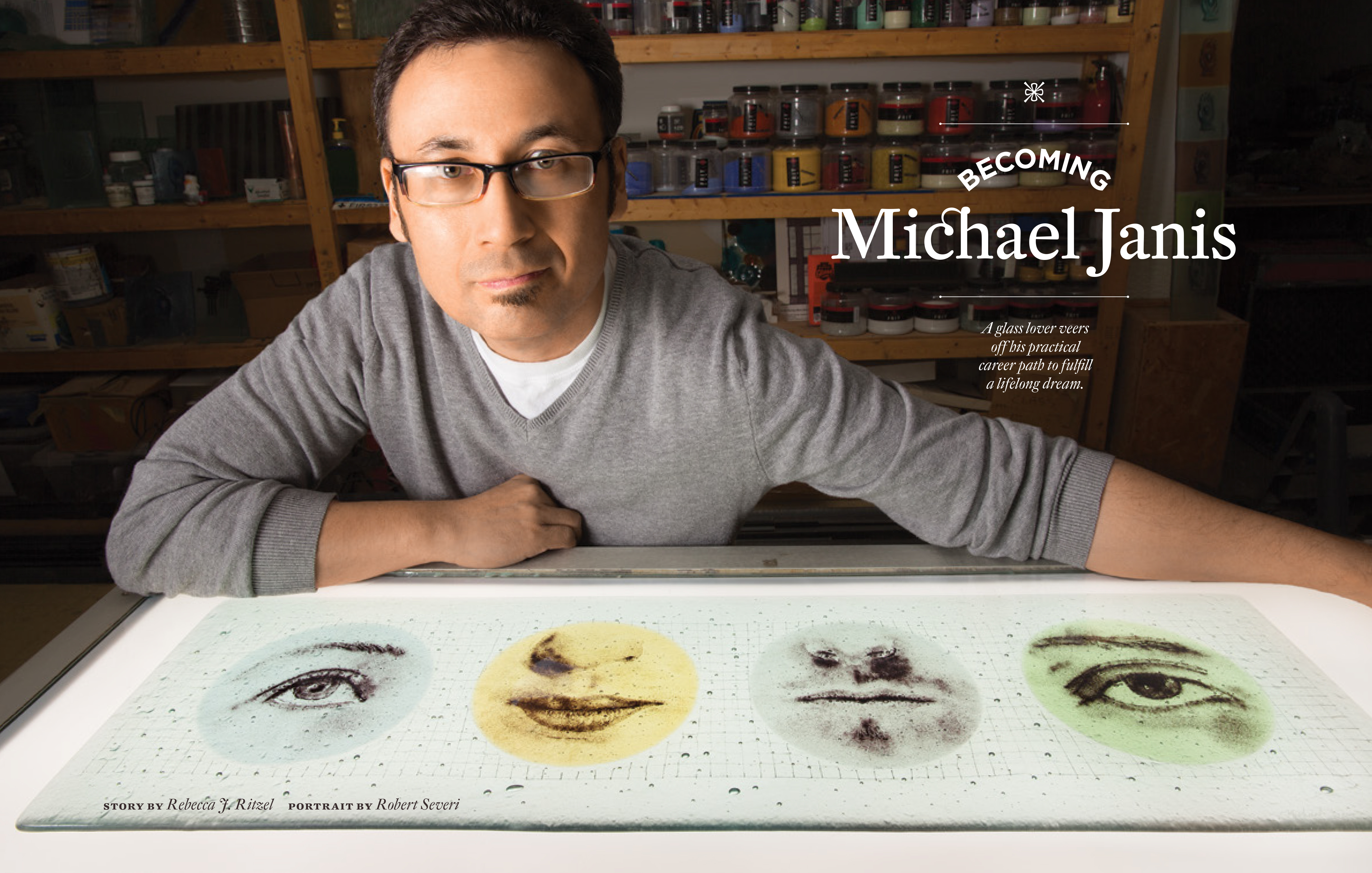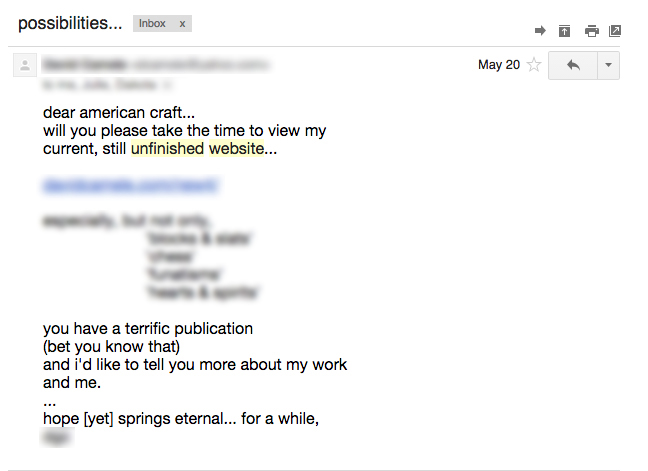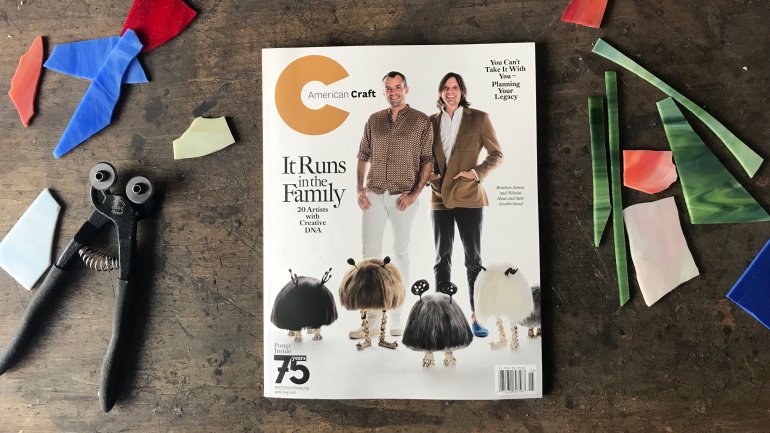Get Your Work Noticed: 10 Tips for Artists
Artists often ask me how they can be covered by American Craft or other media outlets. Deciding who to cover is definitely an art, not a science. There is not a formula. At the American Craft Council, we have various mechanisms for deciding coverage for the magazine, the journal, and the website. We always have more to cover than bandwidth among the staff and space in the print publications. But there are some basic principles that make it more likely we’ll cover someone.
Here’s a recap of advice I gave for a talk at the Center for Craft, Creativity & Design in Asheville, North Carolina, in 2015. Today, I’d say social media is more important in our scouting than it used to be. Other than that, the advice stands.
Make sure your work stands out from the crowd.
We found emerging artist Jennifer Merchant in 2012 and were intrigued by what she could do with acrylic and magazine pages. I haven’t seen jewelry like this from anybody else. And jewelry is a crowded field. Joe Pintz makes tableware out of clay meant for bricks, which gives his work a weight and Flintstone-primitive quality that is unusual. Michael Janis draws with tiny beads of powdered glass in ways that are really subtle and compelling. And Colette Fu makes pop-up books out of intimate documentary photographs she has made among minorities in China. Her work is unique.

Have a good, comprehensive website, and keep it up to date.
Now, I know most artists would rather be making work than worrying about a website, but this is really important. It’s a huge disappointment to come across one striking piece of work by an artist, only to go to their website and discover the work is from 2011, and apparently they haven’t done anything since. We’re not going to do a story on somebody who appears inactive.
Occasionally, I have emailed artists I really am interested in to ask, um, just wondering, what are you up to lately? Can you send me pictures? But don’t count on it. I am really busy, and if I find only one or two old pieces of interest by an artist, I will likely move on to somebody else.
Share recent work on social media.
I tend to look for a website first. But lots of editors look for presence on social media. Adam Field is not only very active on social media, but he tells us, right on his homepage, how to find him on Instagram, Facebook, Pinterest, and YouTube. If you prefer to keep the world updated through social media, that’s fine. Just give us links on your website.
Wherever you do it, we want to know the juicy bits about you. Here’s a bio, with a picture, about Shenequa Brooks, whom we wrote about. Notice that her bio is not her artist statement. I know people slave over artist statements, but when we are scouting for content, we want a bio first. Where do you live? How did you get there? What do you do? Why do you do it? What makes you interesting? We want to know. That helps us envision a bigger story.
Include a résumé or CV on your website.
It helps communicate your level of experience. We want to know if we should consider you for an emerging-artist story, a more substantial mid-career piece, or something even more. Rowland Ricketts has a more in-depth résumé that is a downloadable PDF. When it came time to interview him and his wife, the writer was already several steps ahead in terms of being informed.
Skip the contact form.
List your email address, and tell us where you live. Annie Evelyn does this on her site. It helps us figure out if you are good for the mix and if we have a photographer nearby. Many artists use those impersonal contact boxes, the ones that give no clue as to where they live. I don't know an editor who likes those. Fill one out, and it feels like you are sending a note into the ether. I had to use one the other day that allows only 125 characters – more limiting than a tweet. I wanted photos from an artist to go with a story about their unusual medium. And my note in that contact box read like a telegram or a ransom note or something: “Need pictures of your XYZ work fast. 8-10, high-res, with captions, credits. Please help. American Craft editor.” It was goofy.
If you have the time, start and maintain a blog.
It helps us understand you more, get a sense of how you think and communicate, how you might come across in a publication or on the website. It helps us make our reporting deep and interesting. Check out quilter Paula Kovarik’s homepage. Very prominent is a link to her blog, her “journal.”
If you click that link, you notice her latest entry is a couple of weeks ago. That’s good. Up across the top are links to other recent entries. Those convinced us to do a story on Kovarik. By the time we decided to do the story, we already knew a lot about her and were able skip the superficialities in the interview and write a better story. Kovarik is comfortable showing works in progress and discussing her stumbles along with her successes, which made her very appealing to us. She’s down-to-earth and transparent – which means human and interesting – and that was obvious from her website.
Reach out to editors.
So the question arises: Can you contact us? Can you pitch yourself directly to us? As a person who is inundated by email – more than 1,000 emails a week – I hate to say yes. But sometimes we’re really grateful to have been contacted. There are ways not to contact us, though:

And this was not the first time this guy had written us. Our response: Let us know when you've finished your website. You could also learn our names, and tell us in the subject line what's most interesting about your story. We get lots of these kinds of emails, and we pay most attention to the ones that convey clear competence and consideration for our insane schedules.
Know when to get in touch.
In general, we want to know about artists with distinctive work who are reaching milestones. For example, in a new show. Just graduating can be great – it can be hard to find emerging artists. Newly represented by a gallery. Just having been awarded a grant, a residency, or some other honor. Finishing a new body of work. Or joining a collective.
That’s how we found these guys, Wax Surf Company. They were announcing their connection with online shop Fiercely Made, and we got wind of it. We always wanted to do something on custom surfboards.
Observe good email etiquette.
Be brief, be direct. Personalize the subject line, because otherwise I’ll miss it in the morass of mass emails I get. Don’t write us, as one person did recently, and say, I want to write a 5,000-word, first-person article. Because we don’t do that. Ideally, if you're going to pitch yourself, you know enough about the magazine to know where you might fit.
One cool thing people do sometimes is suggest other artists or recommend shows to preview or even offer to write a quick blog post for our website. That helps us and endears them to us. Over time, those things add up.
Be patient.
We work four to six months in advance, and sometimes we love an artist but need to wait for the right theme or moment. The other day, a guy contacted us about a new body of work, “based on a sense of place,” he said. We looked at his work, which was intriguing, and thought, yeah, let’s keep an eye on him. Why? Because we have a sense-of-place issue coming up and he’d be perfect. But, frankly, he’ll have to wait a few months. Maybe a year.
Bottom line: If you’re strategic and diligent and your work is strong, you have a great shot at getting an editor’s attention. Good luck!




